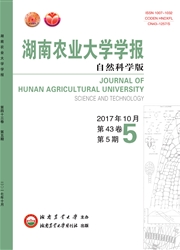

 中文摘要:
中文摘要:
为给白术粗多糖在饲料工业中的开发和应用提供理论依据,选用28日龄二元杂交断奶仔猪(长×大)150头(平均体重为7.5kg)进行试验.将试验猪随机分为5组:Ⅰ组(CK):饲喂基础日粮;Ⅱ组(ANT):饲喂基础日粮+抗生素;Ⅲ组(0.3%PAM):饲喂基础日粮+0.3%白术粗多糖;Ⅳ组(0.6%PAM):饲喂基础日粮+0.6%白术粗多糖;Ⅴ组(0.9%PAM):饲喂基础日粮+0.9%白术粗多糖.试验分两期进行,共28d:第1期(第1~14天)和第2期(第15~28天).结果表明,日粮中添加适宜剂量的白术粗多糖不仅能够显著提高平均日增重,还能提高饲料报酬,降低腹泻率.同时对于相关的血液生化指标,0.6%和0.9%添加量的白术粗多糖组也表现出优予基础组和抗生素组的趋势,且以0.6%的白术粗多糖添加组的效果最为稳定.
 英文摘要:
英文摘要:
It will be a theoretical support for the development and utilization of the polysaccharides of Atractylodes macrophala Koidz on feed industry. A total of 150 two-line crossbred (Landrace×Yorkshine)28-day early-weaned piglets(average weight is about 7.5 kg) were randomly assigned to 5 treatments with 3 replicates. Ⅰ.based diet group(CK), Ⅱ.based diet+antibiotic group, Ⅲ.based diet+0.3% polysaccharide added group, Ⅳ.based diet+0.6% polysaccharide added group, Ⅴ.based diet+0.9% polysaccharide added group. This experiment had two phases, a total of 28 days: the first phase (1~14 days), the second phase(15~28days). The results showed that adding proper polysaccharides to diets could not only increase ADG significantly (p〈0.05), but also increase the F/G, decrease the diarrhea ratio. And for the correlative blood biochemistry indexes, group Ⅳ and Ⅴ were better than group Ⅰ and Ⅱ, and the effect of group Ⅳ was the most stable.
 同期刊论文项目
同期刊论文项目
 同项目期刊论文
同项目期刊论文
 期刊信息
期刊信息
